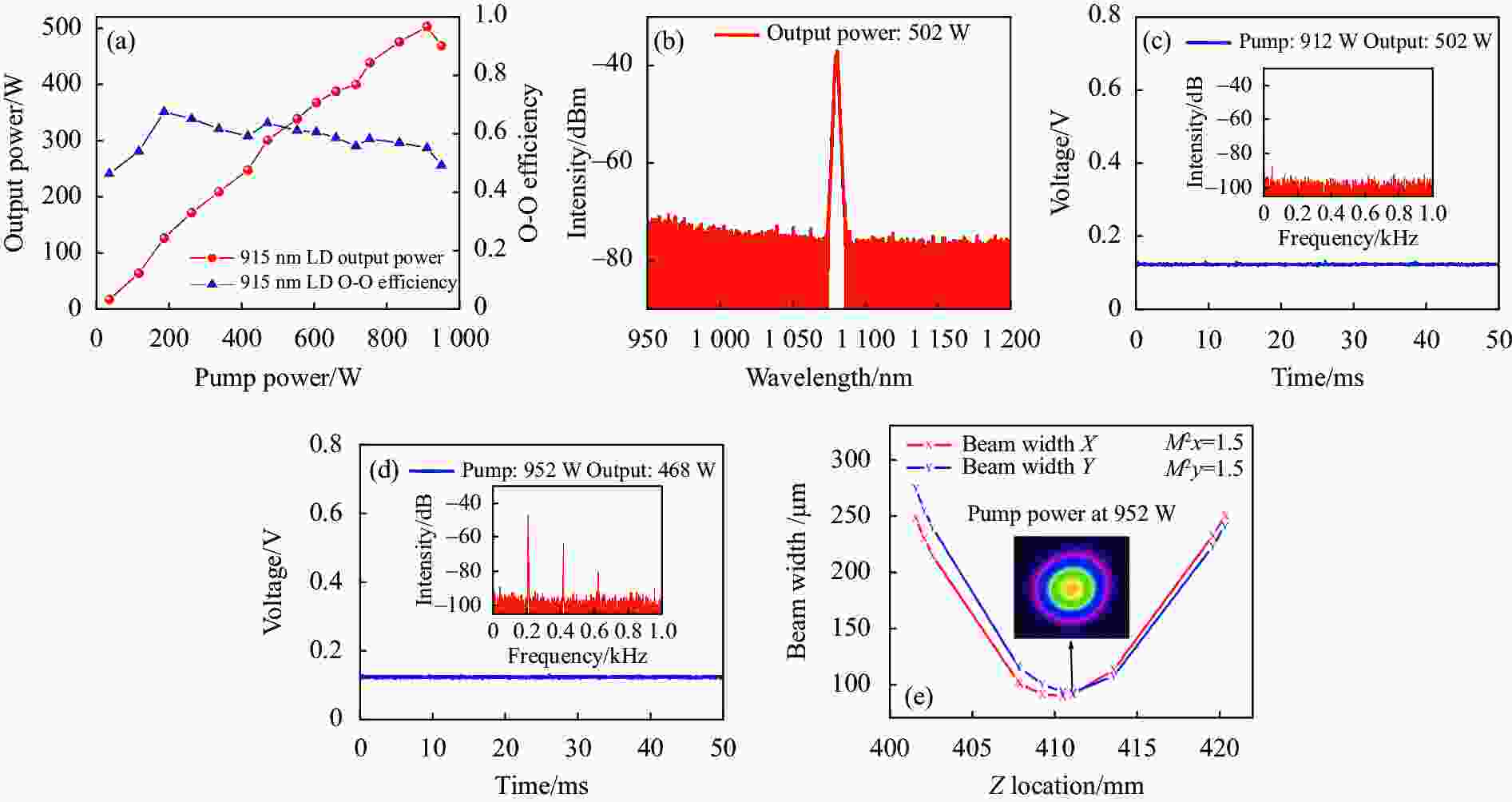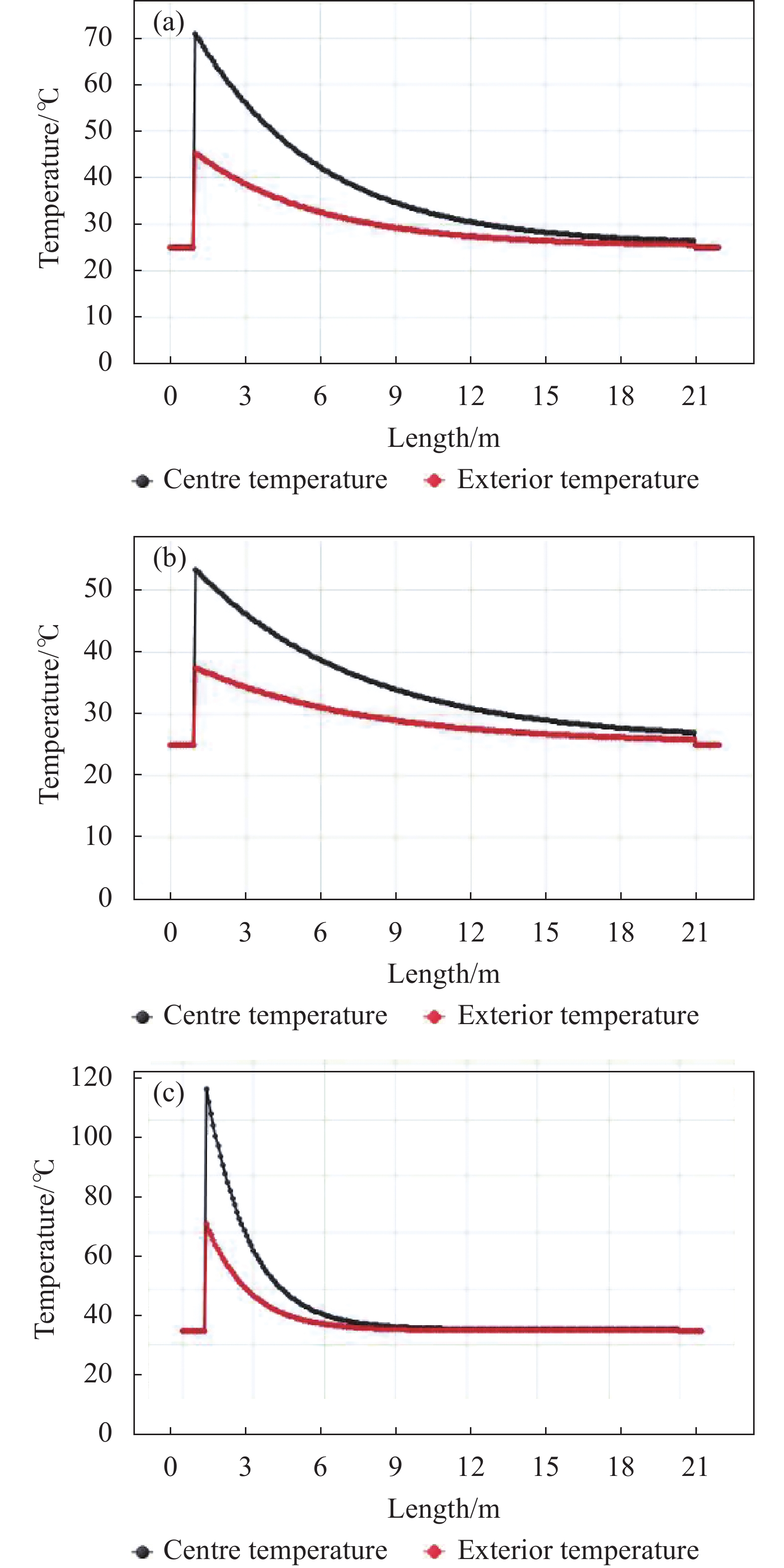-
光纤激光器以其优良的光束质量、可柔性操作、热管理方便、结构紧凑等优点广泛应用于工业加工、医疗卫生、基础研究等领域[1-2]。近年来,随着高亮度泵浦源、光纤器件制造水平、光纤拉制工艺等技术的发展,光纤激光器的输出功率得到了迅速提升[3-8]。长期以来,受激拉曼散射等非线性效应和模式不稳定效应严重制约了光纤激光器功率水平的进一步提升。自2010年德国耶拿大学首次公开报道模式不稳定现象之后,研究人员逐步意识到模式不稳定效应已经成为限制高功率光纤激光器功率提升的重要因素之一[9]。
模式不稳定效应是指当激光器泵浦功率超过某一阈值时,激光器中的基模与高阶模发生动态耦合的现象。模式不稳定现象发生后,信号光经包层光滤除器之后会出现功率滞涨、时域起伏、光束质量退化等现象,严重影响了光纤激光器功率的提升。近年来,研究人员针对模式不稳定现象进行了大量的理论和实验研究,对模式不稳定物理机理和影响因素认识逐步深入并提出了一些有效的抑制方法[10-13]。目前,研究人员普遍认为光纤中废热导致的热效应是高功率光纤激光器中产生模式不稳定的根源。
通常认为,激光介质内的主要发热因素是抽运光子与激光光子之间的能量亏损,即量子亏损。首先,从光纤中的热量计算公式出发,推理出光纤中的热量不仅与量子亏损有关,还与增益光纤的吸收系数相关。利用光纤激光器仿真软件SeeFiberLaser仿真了不同波长泵浦光纤激光器时增益光纤中的热量分布情况[14]。结果表明,采用不同泵浦源时,泵浦吸收系数越低增益光纤中的温度及温度梯度越低。这说明,泵浦吸收系数对光纤激光器模式不稳定阈值的影响比量子亏损对模式不稳定阈值的影响更大。最后,在理论研究基础上搭建了前向泵浦掺镱光纤激光振荡器,对比研究了915、940、976 nm LD分别泵浦时激光器的模式不稳定阈值特性,实验结果与理论相吻合,为进一步提高模式不稳定阈值,获得更高功率光纤激光器提供了有效参考。
-
增益光纤中的热负荷是产生模式不稳定效应的根源。在增益光纤内部的热源可以描述为[15]:
式中:Q为光纤中的热量;r为光纤半径;z为光纤轴向距离;N0为掺杂粒子浓度;N2为上能级粒子数;vp和vs为泵浦光和信号光的频率;σap和σep为泵浦光的吸收和发射截面;Pp(r,z)为泵浦光功率;Ap为传输泵浦光的内包层面积;αs(r)为信号光吸收损耗系数;Is(r,z)为信号光强。
在实际应用中,一般采用泵浦吸收系数βp(λ)对光纤的吸收特性进行描述,考虑到泵浦吸收系数与泵浦吸收截面之间的关系:
将公式(2)代入公式(1),增益光纤内部的热源可以描述为[16]:
式中:k0为常数4.34;Γp为泵浦填充因子。
从公式(3)可以看到,光纤中的热源不仅来源于量子亏损,还与增益光纤的泵浦吸收系数有关。为了降低光纤中的热量、抑制模式不稳定效应,一方面可以提高激光器的量子效率,另一方面还可以降低增益光纤的泵浦吸收系数。一直以来,人们都认可提高量子效率可以提升模式不稳定阈值的方案,但对于降低泵浦吸收系数提高模式不稳定阈值的认识不够深入。在实验中发现,光纤激光器在采用915 nm LD泵浦时比采用976 nm LD泵浦时具有更高的模式不稳定阈值[17]。这说明量子效率并不是影响光纤激光器热致模式不稳定阈值的主要因素,泵浦吸收系数对模式不稳定阈值的影响比量子亏损对模式不稳定阈值的影响可能更大。为进一步揭示量子亏损和泵浦吸收系数对模式不稳定阈值的影响,根据理论模型,利用课题组开发的光纤激光仿真软件SeeFiberLaser对不同泵浦波长情况下光纤激光器中的热量进行了仿真计算。
由镱离子的吸收发射截面可知,当使用同一根光纤时,泵浦源波长不同,吸收系数则不同。根据实验室现有泵浦源,分别仿真了915、940、976 nm LD泵浦时增益光纤中的热量情况。在SeeFiberLaser软件中搭建激光器结构如图1所示,各连接点的损耗均为0,环境温度为25 ℃,换热系数为1200 W/(m2·K)。为更好的贴近现实,各器件参数设置参照实验所使用器件参数,主要参数设置如下:连续泵浦源波长分别为915、940、976 nm,注入功率为1200 W,3 dB带宽为3 nm;前向泵浦合束器平均泵浦效率98%,信号传输效率98%;双包层光纤光栅中心波长均为1080 nm,尾纤纤芯和包层直径分别为30 μm和400 μm,反射率分别为99.9%和10%,3 dB反射带宽为别为4 nm和1.7 nm;双包层掺镱光纤的纤芯包层直径分别为30 μm和400 μm,915 nm处的吸收系数为0.88 dB/m,在976 nm处的吸收系数为2.73 dB/m,940 nm处的吸收系数为0.68 dB/m,长度为20 m;光纤端帽反射率为0。
仿真结果如图2所示,其中图2(a)~(c)分别为915、940、976 nm LD泵浦时纤芯和包层中的温度变化图。从图中可以看到,光纤所达到的最高温度分别70.93、53.26、110.89 ℃,温度差异明显,最高相差约57 ℃,温差的主要来源为量子亏损和泵浦吸收系数。对比可以发现,量子效率最高的976 nm LD泵浦时,光纤的温度和温度梯度最高,量子效率最低的915 nm LD泵浦时,光纤中的温度和温度梯度处于中间位置;对比吸收系数,吸收系数最高的976 nm LD泵浦时,光纤中的温度和温度梯度最高,吸收系数最低的940 nm LD泵浦时,光纤中的温度和温度梯度最低。所以,相比于量子亏损,吸收系数对光纤中的温度及温度梯度影响更大。高功率光纤激光器的模式不稳定主要是由于光纤中的废热所产生的热致折射率光栅。而光纤中的温度和温度梯度越高,越容易引起光纤的热致折射率变化,从而形成热致折射率光栅,降低模式不稳定阈值[18]。综上,泵浦吸收系数对光纤激光器模式不稳定阈值的影响比量子亏损对模式不稳定阈值的影响更大。
-
为了研究不同波长泵浦时激光器的模式不稳定阈值特性,搭建了如图3所示的前向泵浦光纤激光振荡器。1组750 W的976 nm LD、2组750 W的915 nm LD和2组680 W的940 nm LD通过(6+1)×1前向合束器((6+1)×1 FPSC)注入到激光器谐振腔中。谐振腔由掺镱双包层光纤(YDF)和一对中心波长为1 080 nm的光纤光栅构成。其中高反射率光纤光栅(HR FBG)反射率为99.9%,3 dB带宽为4 nm;低反射率光纤光栅(OC FBG)反射率为10%,3 dB带宽为1.7 nm。掺镱双包层光纤的纤芯包层的直径分别为30 μm和400 μm,在915 nm处的吸收系数为0.88 dB/m,长度为20 m。实验中,为了增加高阶模式的损耗,将掺镱双包层光纤最小弯曲直径设定为85 mm。谐振腔中产生的激光经过包层光滤除器(CLS)后从光纤端帽(Endcap)输出。包层光滤除器将激光器中未吸收的泵浦光和诱发模式不稳定效应的高阶模式滤除。为了避免反馈光导致激光器自激,对(6+1)×1前向合束器的信号臂切8°斜角。输出激光经准直后,通过一个分束系统将激光注入功率计(PM)、光谱仪(OSA)、示波器(PD)和光束质量测试仪(Beam Squared)中,分别测量和记录输出功率、光谱、时域以及光束质量M2因子。
-
自模式不稳定现象公开报道之后,研究人员从多个方面对模式不稳定现象展开分析,大量实验研究表明,高功率光纤激光器中模式不稳定阈值具有明显的“阈值性”[19]。模式不稳定阈值附近的时域特性具有“周期性”,特征频率耦合在kHz量级,输出信号光经包层光滤除器之后功率滞涨等特征[20]。利用模式不稳定这些特征属性,可以准确的判定模式不稳定阈值。实验中,由于采用了小弯曲结构盘绕增益光纤和包层光滤除器过滤高阶模,在达到模式不稳定阈值之后不会出现光束质量下降现象。
实验中,首先采用工业高效率激光器泵浦源976 nm LD作为该振荡器的泵浦源进行实验,得到实验结果如图4所示。图4(a)为不同泵浦功率情况下输出功率及对应的光光转换效率。可以看到,在低功率时输出功率随泵浦功率成线性增长趋势,但是当泵浦功率达到412 W之后,输出功率出现下降,对应的光光转化效率由最高时的67%下降到48%。利用光谱仪测量得到的光谱数据如图4(b)所示,光谱中没有明显的拉曼成分,故功率降低与光光转化效率下降与受激拉曼散射效应无关。利用光电探测器测量输出功率为279 W时的时域信号以及傅里叶变换后的频域信号如图4(c)所示。在泵浦功率为412 W,输出功率为279 W时,时域上没有观测到明显的波动,频域也没有出现模式不稳定效应特征峰。图4(d)为泵浦功率483 W,输出功率235 W时的时频域信号,结果显示,在泵浦功率为483 W时,时域上出现周期性的起伏,频域上可以观察到明显的模式不稳定效应特征峰。在泵浦功率为483 W时测得光斑形态如图4(e)所示,对应的光束质量因子为M2x=1.4、M2y=1.4。根据实验中测得的功率和光光转化效率下降现象和时频域信号,可以判定976 nm LD作为泵浦源时,该振荡器的模式不稳定阈值约为279 W。

Figure 4. Output characteristic of fiber oscillator when pumped with 976 nm LD. (a) Output power and optical-to-optical(O-O) efficiency under different pump power; (b) Optical spectrum at the output power of 279 W; (c)-(d) Time domain signals and their Fourier spectra at the output power of 279 W and 235 W, respectively; (e) Beam quality factor and beam profile when the pump power is 483 W
随后采用工业应用中稳定性较好的激光器泵浦源915 nm LD对光纤激光器进行泵浦,得到实验结果如图5所示。图5(a)为不同泵浦功率情况下输出功率及对应的光光转换效率曲线。可以看到,与976 nm LD泵浦时类似,在低功率时输出功率随泵浦功率成线性增长趋势,在泵浦功率为912 W时,最高输出功率达到502 W。当泵浦功率继续增加到952 W时,输出功率下降为468 W,对应的光光转化效率从最高时的61%下降到49%。利用光谱仪测量得到的光谱数据如图5(b)所示,由于功率较低光谱中没有明显的拉曼成分,故功率降低和光光转化效率下降与受激拉曼散射效应无关。利用光电探测器测量输出功率为399 W时的时域信号以及傅里叶变换后的频域信号如图5(c)所示。在泵浦功率为749 W,输出功率为399 W时,时域上没有观测到明显的波动,频域也没有出现模式不稳定特征峰。图5(d)为泵浦功率912 W,输出功率502 W时的时频域信号,可以看到,时域上出现周期性的起伏,频域上可以观察到明显的模式不稳定效应特征峰。在泵浦功率为952 W时测得激光器远场光斑形态如图5(e)的插图所示,对应的光束质量因子为M2x=1.5、M2y=1.5。根据实验中测得的功率和光光转化效率下降现象以及光谱和时频域信号,使用915 nm LD泵浦时,该激光器的模式不稳定阈值约为502 W。

Figure 5. Output characteristic of fiber oscillator when pumped with 915 nm LD. (a) Output power and O-O efficiency under different pump power; (b) Optical spectrum at the output power of 502 W; (c)-(d) Time domain signals and their Fourier spectra at the output power of 502 W and 468 W, respectively; (e) Beam quality factor and beam profile when the pump power is 952 W
最后,采用工业应用不多,但有望提高模式不稳定阈值的940 nm LD作为该振荡器的泵浦源进行实验,得到实验结果如图6所示。图6(a)为不同泵浦功率情况下输出功率及对应的光光转换效率。与976 nm LD和915 nm LD泵浦时类似,在低功率时输出功率随泵浦功率成线性增长趋势,但是当泵浦功率达到1144 W之后,输出功率出现下降,对应的光光转化效率由最高时的63%下降到59%。利用光谱仪测量得到的光谱数据如图6(b)所示,光谱中没有明显的拉曼成分,故功率降低与光光转化效率下降与受激拉曼散射效应无关。利用光电探测器测量泵浦功率1144 W,输出功率为697 W时的时域信号以及傅里叶变换后的频域信号如图6(c)所示。在输出功率为697 W时,时域上没有观测到明显的波动,频域也没有出现模式不稳定效应特征峰。图6(d)为泵浦功率1149 W,输出功率693 W时的时频域信号,结果显示,在输出功率为693 W时,时域上出现周期性的起伏,频域上可以观察到明显的模式不稳定效应特征峰。在泵浦功率为1149 W时测得光斑形态如图6(e)所示,对应的光束质量因子为M2x=1.4、M2y=1.4。根据实验中测得的功率和光光转化效率下降现象和时频域信号,可以判定,940 nm LD作为泵浦源时,该振荡器的模式不稳定阈值约为697 W。

Figure 6. Output characteristic of fiber oscillator when pumped with 940 nm LD. (a) Output power and O-O efficiency under different pump power; (b) Optical spectrum at the output power of 697 W; (c)-(d) Time domain signals and their Fourier spectra at the output power of 697 W and 693 W, respectively; (e) Beam quality factor and beam profile when the pump power is 1149 W
如表1所示,分别利用976、915、940 nm LD泵浦纤芯/包层直径为30/400 μm的掺镱光纤振荡器时,激光器的模式不稳定阈值分别为279、502、697 W,光光转化效率分别为67.7%、61%和63%,且均能保持近单模光束质量。对比仿真结果可以看到,泵浦吸收系数越高,相同泵浦功率水平下增益光纤温度越高,激光器实际模式不稳定阈值越低,理论与实验结果相吻合。
Pump wavelength/nm Pump absorption coefficient/dB.m−1 Active fiber maximum temperature/℃ TMI threshold/W O-O conversion efficiency 976 2.73 110.89 279 67.7% 915 0.88 70.93 502 61% 940 0.68 53.26 697 63% Table 1. TMI threshold for different pump wavelengths
-
实验结果表明,泵浦吸收系数最低的940 nm LD具有最高的模式不稳定阈值,泵浦吸收系数最高的976 nm LD模式不稳定阈值最低。分析主要原因有以下三点:一是吸收系数较低的泵浦波长使得增益光纤温度梯度较低,有利于抑制热致折射率光栅的形成,提高模式不稳定阈值;二是吸收系数较低的泵浦波长对应较低的吸收截面,使得激光器的上能级粒子数较低,增加了空间烧孔效应,提高了模式不稳定阈值[21];三是吸收系数较低的泵浦波长增强了增益饱和效应,提高了模式不稳定阈值[22]。所以,通过改变泵浦波长降低泵浦吸收系数可以有效提升模式不稳定阈值。
随着大模场光纤的使用,模式不稳定效应已经成为高功率光纤激光器功率提升的重要限制因素。在理论推导的基础上结合仿真设计实验,得出影响光纤激光器模式不稳定的热效应主要来自于泵浦吸收,而不是量子亏损。这一项新的研究表明,目前所广泛采用的976 nm LD可能不是实现高功率激光输出的理想泵浦源。下一步将根据实验结果,优化泵浦波长,兼顾量子效率和泵浦吸收系数,实现高模式不稳定阈值和光光转化效率,为实现5~10 kW高功率高光束质量光纤激光器提供新的泵浦源。
Transverse mode instability effect of fiber lasers with different pump wavelengths
doi: 10.3788/IRLA20210256
- Received Date: 2022-01-20
- Rev Recd Date: 2022-02-25
- Accepted Date: 2022-03-07
- Publish Date: 2022-05-06
-
Key words:
- fiber laser /
- transverse mode instability /
- thermal effect /
- pump absorption coefficient
Abstract: It is generally believed that the transverse mode instability (TMI) of fiber laser mainly comes from the thermal effect caused by the quantum defect of the pump source and the pump absorption of gain fiber. Theoretically, based on the analysis of the heat source in optical fiber, it was found that the thermal effect of induced mode instability mainly comes from pump absorption, followed by the quantum defect. And the simulation software SeeFiberLaser developed by the research group was used to verify the conclusion. The simulation results showed that the lower the pump absorption coefficient, the lower the maximum temperature and temperature gradient in the fiber, the more beneficial it was to restrain the formation of thermally induced refractive index grating and increase the TMI threshold. Experimentally, a co-pumped ytterbium-doped fiber laser oscillator with a core/inner cladding diameter of 30/400 μm was built and comparatively studied on TMI threshold characteristics of lasers pumped by laser diodes (LDs) with central wavelengths of 976 nm, 915 nm and 940 nm. The results showed that when 976 nm LD, 915 nm LD and 940 nm LD were used as pump sources, the laser TMI threshold was 279 W, 502 W and 697 W respectively, and the laser optical-to-optical (O-O) conversion efficiency was 67.7%, 61% and 63%, respectively. It was be found that the influence of the pump absorption coefficient on the TMI threshold was greater than that of the quantum defect on the TMI threshold, and the TMI threshold could be effectively increased by changing the pump wavelength and reducing the pump absorption coefficient. Optimizing pump wavelength, taking into account both quantum efficiency and pump absorption coefficient, was one of the important technical routes for fiber lasers to achieve high beam quality and high mode instability threshold.













 DownLoad:
DownLoad:




